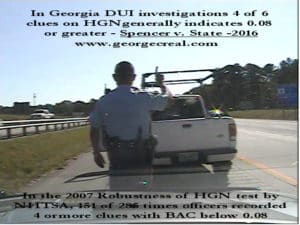
First, the legal limit is not relevant in a less safe DUI case because there is no legal presumption of impairment for purposes of less safe driving except for the presumption of sobriety under 0.05 and no presumption between 0.05 and 0.08 under OCGA 40-6-392. You have to be charged with DUI per se for the 0.08 legal limit to be relevant. In Baird v. State, 260 Ga. App. 650 (2003), the Court of Appeals explained, “To win a DUI conviction under the “less safe driver” statute,[6] the State must prove that the defendant had impaired driving ability as a result of drinking alcohol.[7] As we noted in Evans v. State,[8] “impaired driving ability depends solely upon an individual’s response to alcohol.”[9] Because individual responses to alcohol vary, the presence of alcohol in a defendant’s body, by itself, does not support an inference that the defendant was an impaired driver.
Second, the Horizontal Gaze Nystagmus Test is far from foolproof. In the 2007 study titled, “The Robustness of Horizontal Gaze Nystagmus Test” by NHTSA, the raw data shows that out of 258 HGN tests administered 151 times officers found 4 or more clues out of 6 total clues and the test subject later blew under the legal limit of 0.08 grams blood alcohol content. This means that your definition of: ”generally” is 47% of the time.
HGN is not a breath test. HGN is just a breath guess.
-Author: George Creal

